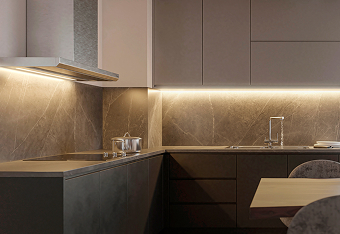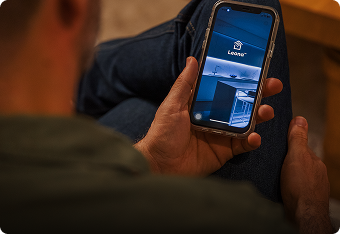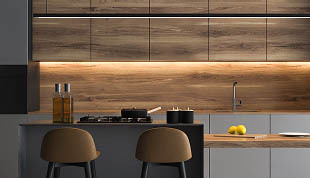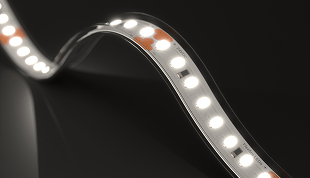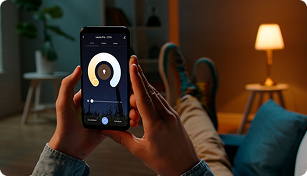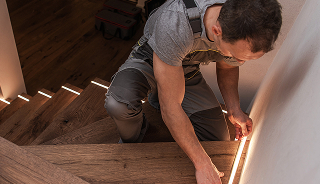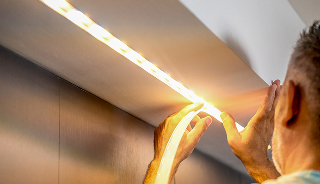LED Installation Guides
LED Installation Guides
Guides by Room
Kitchen Guides
Under Counter Lighting Guide
Under Cabinet Lighting Guide
Living Room Guides
Cove Lighting Guide
Stairway Lighting Guide
Bathroom Guides
Bathroom Lighting Design Guide
Vanity Lighting Guide
Guides by Product
LED Strip Lights
General LED Strips Installation Guide
LED Fixtures
ClickBright™ Light Bars
Victory™ Puck Lights
Endeavor™ 120V Cove Light
LED Specialty Lights
White LED Sign Modules
RGB LED Sign Modules
Lucid™ Flexible LED Neon Strip Light
LED Connectors
IP20 Connectors Installation Guide
IP65 Connectors Installation Guide
LED Power Supplies
Zurik® Universal Hardwired Power Supply
Zurik® EMLV 30W Dimmable LED Driver
Zurik® EMLV 60W Dimmable LED Driver
Mean Well™ HLG/LPV Series LED Driver
LED Mounting Channels
Surface-Mount & Angled Channels
Recessed Channels
Titan Pendant Kit Guide
Channels Fit Guide
LED Controllers & Dimmers
Leviton Decora Dimmer
Lutron C.L. Diva Dimmer
Leona® Smart Home System
Leona® Pro Smart Home Controller
Leona® Pro Smart Home Remote
Leona® Pro Smart Home Control Panels
Leona® Digital Controller
Leona® Door Sensor
Leona® Motion Sensor
Leona® Smart Home Outlet
Leona® Smart Home Plug
DMX
DMX Lite™ Tunable White Controller
DMX Lite™ RGB/RGBW Controller
DMX Lite™ RGB Tunable White Controller
DMX512 4-Channel Decoder
DMX512 5-Channel Decoder
DMX to SPI Decoder
DMX/RDM 8-Way Splitter
Nicolaudie Stand Alone Controller
Nicolaudie Stick CW4
Nicolaudie Stick DE3
LED Strip Lights Installation Video
10 Key Installation Questions, Answered
Can I control my lights with Alexa, my phone, a remote, or smart devices like iHome or sensors?
You can control your lights with Alexa, Google Home, and our Leona® Smart App by using our Leona® Pro Smart Home Controller. It’s built to work with those three.
If you’re wondering whether you can group controllers, whether you need both a driver and a controller, or if it’ll work with motion sensors, yes, you can!
You can group Leona® Controllers into one zone to manage every light in your space at once, or split them into different zones for more control and diverse settings.
You’ll always need a power source that matches your lights, usually 12–24VDC.
And yes, the Leona® Pro Smart Home Controller works with our Leona® Smart Motion Sensors—your go-to for lighting things up when someone moves or opens a door or drawer.
What wire gauge should I use for my LED strip run?
We usually ask ourselves this when we’re planning a longer run, using more than one strip, or concerned about voltage drop and safety.
The truth is we can’t give an exact wire size, since we’re not licensed electricians. For a safe and reliable install, we strongly recommend checking with a qualified electrician.
You can also try an online voltage drop calculator—it helps you choose the right wire size based on your system’s voltage, power load, and wire length.
As a rule of thumb, try to keep the voltage drop under 3% between the driver and the start of your LED strip. That helps your lights run better and stay bright.
Can I use an AC wall dimmer or on/off switch with Leona or other LED strips?
When using the Leona® system, standard wall dimmers won’t work for dimming. Instead, you’ll control dimming through the Leona® app or with Leona remotes.
If you want something on the wall, the Leona® Control Panel gives you just that feel—it’s built just for the system.
If you’re using a regular, hardwired wall dimmer (not part of the Leona® system), it must be paired with a dimmable driver. This setup only works with plain white strips, not tunable white or color-changing ones.
Can I use RGB strips to create white light? Doesn’t RGB already include white?
RGB strips can make a kind of white by mixing red, green, and blue—but it’s not true white. It usually looks very cool (like bluish or pinkish light) and can shift depending on how you view it.
If you want better, more pleasing, 100% real white light, here’s what we suggest:
• Use RGB + white LED strips for a soft warm white around 3000K, ideal for most everyday tasks and mild relaxation.
• Or try RGB + tunable white LED strips for full control, from cozy warm (2400K) for deep relaxation to sharp cool (6500K) for work and staying active. These options give you a more natural and steady whites. No odd colors, just better results.
Can I run 150+ ft of LED strip from one power source or AC outlet?
Running more than 150 ft of LED strip from a single power supply or outlet usually isn’t recommended. That’s because LED strips need a steady amount of power, and the longer the run, the harder it is to deliver that power evenly. This can cause something called voltage drop, where the lights at the far end start to look dim.
If you’re wondering how many feet your power supply can handle, it comes down to math—how much power (watts) your strip uses per foot, and how much power (watts) your power supply can deliver. For example, if your strip uses 5 W/ft and your power supply can handle 60 W, you're safe running about 12 feet.
If you’re unsure how big your power supply should be, go a little bigger. A good rule of thumb is to choose a supply with about 20% more power than your strip requires. That buffer helps things run smoothly and safely.
If you’re planning a really long run, break it up. Use multiple power supplies or add power in more than one spot along the strip. This keeps the brightness even across the full length—an approach called wiring in parallel.
Where should I install undercabinet lighting: near the front edge or closer to the backsplash?
For the most even light and fewer shadows, it’s best to install your undercabinet lighting near the front edge of the cabinet. That way, the light shines directly onto your countertop where you need it most.
If you place the strip too close to the backsplash, the light may bounce off the wall and create glare or uneven lighting. That said, depending on your cabinet depth and kitchen layout, some people prefer placing the strip in the center.
We recommend doing a quick mock install before peeling the adhesive—test out a few positions and see what looks best in your space.
What’s a parallel connection, and how is it different from a serial connection?
In a parallel connection, each LED strip gets its own wire going back to the power source. This helps keep the voltage steady and the brightness even. It’s also especially helpful for long runs.
Also called series wiring or daisy-chaining, the power in a serial connection flows from one strip to the next. It can also mean using a single long strip without breaks.
How do I use solderless connectors? What’s the difference between grip and terminal connectors?
We often ask this when we’re having trouble getting connectors to fit or stay in place, or when it’s not clear which type to use for the strip we have.
For starters, none of these options require soldering. Grip connectors are tool-free and great for quick, clean installs. They have small hooks that pierce through the solder pads to create a reliable, stable connection.
Terminal connectors, on the other hand, require a screwdriver but offer more control. A small screw holds the LED strip securely in place without piercing the solder pads, making them ideal for wiring into aluminum channels, tight spaces, or temporary installations where you want to avoid altering the strip.
If your connectors aren’t holding properly, double-check that your strip matches the connector type and width, and that the copper pads are fully aligned inside the connector. We recommend checking out our user guides:
• IP20 Grip Connectors (for indoor strips)
• IP65 Grip Connectors (for outdoor strips)
What’s the difference between 12V and 24V LED strips?
The basic difference between 12V and 24V LED strips comes down to how they handle power and voltage drop:
• Voltage Drop: 24V strips can run longer distances with less voltage drop, so they keep their brightness better over longer runs. This makes them better for most applications.
• Brightness: Both 12V and 24V strips can shine just as bright if they have the same LEDs per foot and power rating. Voltage itself doesn’t change brightness.
• Compatibility: Your power supply needs to match the strip voltage—you can’t mix 12V and 24V parts.
We usually recommend 24V LED strips for your space because they work more efficiently and perform better on longer runs. The only time to pick 12V is if you already have a 12V power source, like a driver or battery, which makes things easier to connect.
What’s the best color temperature for different rooms or uses?
Correlated Color Temperature (CCT)—which means the shade of white light of your strips, fixtures, and bulbs—is really important for functionality and interior design, as it really affects how your spaces feel and look. When choosing it, you should think about things like how the space is used, what time of day you’re there, who uses it, existing light sources and decor, and other factors.
Here are some common recommendations:
• Kitchen: 3000 to 4000K → Warm to natural white sets the mood for kitchen conversations and mealtimes, while cool white is great for precision during cooking and prep.
• Bathroom: 3000 to 4000K → Warm white is ideal for achieving a spa-like, relaxing feel, while cool white works better for beauty routines and tasks that require focus.
• Bedroom: 1800K to 3000K → Ultra-warm white helps ease you into sleep before bedtime, while warm white makes winding down feel cozy and relaxed.
• Closet: 4000 to 5000K → Cool white is ideal for catching every detail of your clothes, waking you up after a night of rest and bathroom rituals, and helping you focus while getting dressed.
• Living Room: 2700 to 3000K → Warm white sets the mood for relaxing with family by the TV or hosting friends in cozy gatherings.
• TV Backlight: 2700 to 4000K → Warm to neutral whites help reduce eye strain and improve your viewing experience. Some people also prefer multi-color lights that sync to their screen.
• Office or Task Areas: 4000K to 5000K → Bright, cool white light supports productivity and helps you stay alert during the day—especially for tasks that require your full attention.
• Exteriors: 3000 to 5000K → Warm light gives your facade and shade structures an inviting feel for relaxing outdoors, while cool white enhances visibility, improves security, and draws attention to otherwise darker areas.
Remember: The best choice depends on your personal style and the look you want. Ideally, avoid mixing different color temperatures in the same area to maintain a consistent feel. One great option is choosing dynamic tunable white lights that offer all CCTs and make it easy to adjust your space’s lighting for any mood or time of day—even automatically.
Need Help Finishing the Job?
We’ve covered the basics. But if something’s not quite adding up or your setup looks a little different, we're here to help!


